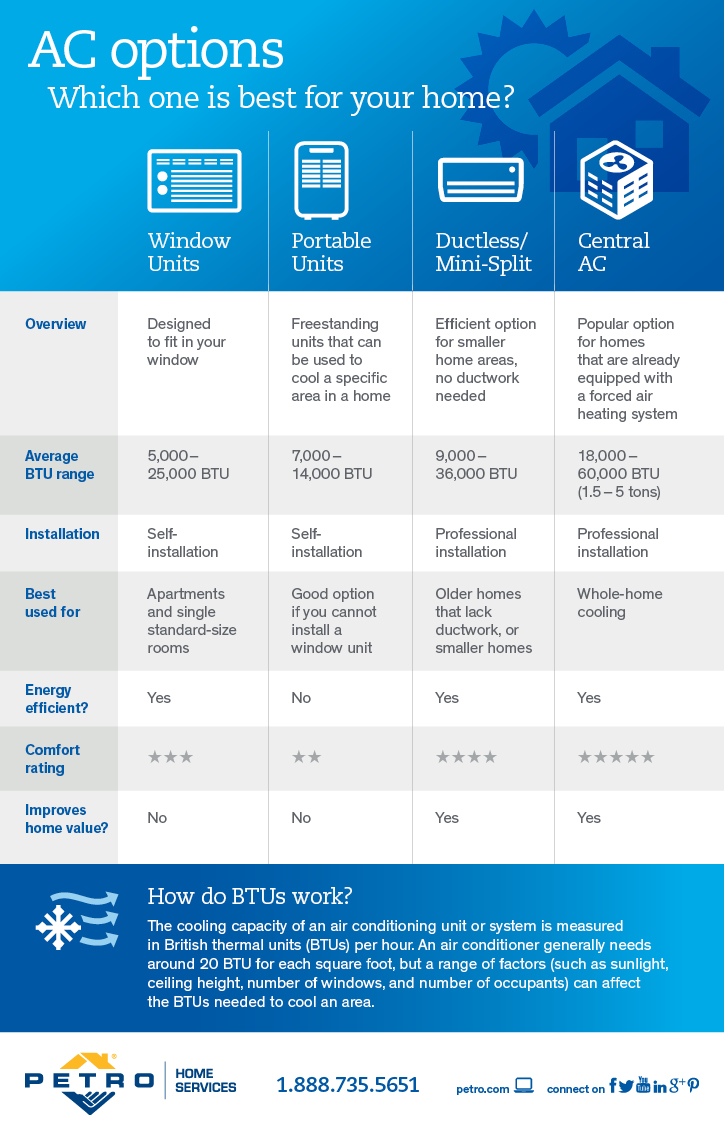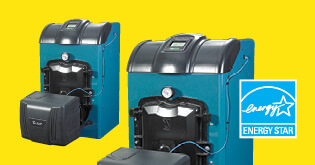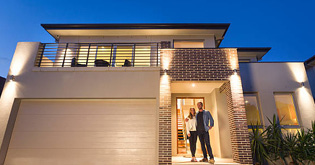- My Account:
- Sign In
- Register
- Make Payment

How to Choose the Best Air Conditioner for Your Home | Petro
As the temperature starts to climb outside, it’s easy to see why air conditioning is a home comfort necessity, especially if you live in an area with high humidity.
There are four main types of home air conditioning units and systems that function on the principle of removing heat. However, when it comes to efficiency levels, aesthetics and the ability to provide comfort, results can vary. In this article, we take a look at the pros and cons of each unit or system to help you decide which is the best option for your home.
Window air conditioners.
Window units are a popular type of cooling equipment designed to fit in double- and single-hung windows. They’re commonly installed in apartments that lack central air conditioning, or they can give a cooling boost to single rooms in larger homes.
- Benefits of using a window air conditioner
Window air conditioners are relatively small, fairly portable and easy to install without a professional’s help. If you have budget constraints, a window unit is the cheapest equipment option for adding air conditioning to your home. Today’s models are up to 30 percent more efficient than those manufactured only a decade ago. They also come with warranties for as long as five years to give you peace of mind when you make your purchase.
- Disadvantages of using a window air conditioner
Just remember, window air conditioners aren’t intended to cool an entire home. Even if you live in an apartment, you’ll need multiple units to keep every room comfortable. Every unit you install impairs your ability to operate that window and blocks your view of the outside. You also have to deal with the noise of a compressor running right by your ear.
If you decide you need a large unit, you may find it difficult to install and remove for winter storage. Factors that can impair window air conditioner efficiency include high ceilings, lots of windows and doors, high sun exposure, and cooling a room on the top floor.

Portable air conditioners.
These units are similar to window air conditioners, but they stand on the floor instead of going directly into the window. The unit draws in air, removes heat and moisture, and vents cool, dry air back into your home. Hot, humid air is vented through an exhaust hose going out the window. This is only a better option to window units if you have the wrong kind of windows, or you’re unable to lift heavier window air conditioners.
- Benefits of using a portable air conditioner
Portable air conditioners are even easier to set up than window units. The floor units roll around on casters so you can position them just right. The hose leading out of the window doesn’t obstruct the view, and it’s easy to temporarily remove the hose so you can operate the window when the weather is nice.
- Disadvantages of using a portable air conditioner
According to Consumer Reports, portable air conditioners tend to only deliver half the cooling capacity they claim, which can leave you feeling hot and sweaty even when the unit is working nonstop. They’re also more expensive and less efficient than similarly sized window units, driving both purchasing and operating costs up. Noise is another factor, and most portable air conditioners have water reservoirs you must drain manually as the unit removes excess humidity from the air.
Ductless mini-split air conditioners.
A ductless mini-split is essentially a heat pump without ductwork. It has two main components. The first is an outdoor compressor, similar to the ones found in central air conditioners. The second is an indoor evaporator coil and air handling unit that mounts to the wall or ceiling. A conduit traveling through a sealed hole in the wall links the two units together.
Ductless mini-split air conditioners are designed for cooling older homes without ductwork, smaller homes and add-ons where adding ductwork isn’t feasible. Some ductless AC models achieve the highest efficiency ratings of any type of air conditioning system.
- Benefits of using a ductless mini-split air conditioner
The main advantage of mini-splits is their ability to provide flexible cooling to individual parts of your home, all while maintaining a small size and energy efficient operation. It’s the closest thing you can get to central air conditioning without the need to tear up your ceiling and walls to install ductwork. Plus, since mini-splits are a type of heat pump, they can also provide home heating in the winter.
As an added bonus, ductless mini-splits operate as quietly as an ordinary fan. Since the compressor is located outside, these units are much quieter than a window or portable home air conditioner. Plus, with no need to access the window during installation, mini-splits provide better home security, an unobstructed view of the outside, and the ability to operate the window whenever you want.
- Disadvantages of using a ductless mini-split air conditioner
Keep in mind that ductless mini-splits are more expensive than window or portable units. You also need a professional to perform the installation, which includes drilling a three-inch hole in the wall to link indoor and outdoor components. You also need to take interior design considerations into account since the unit mounts to the wall or ceiling of the room you want to heat or cool.
Central air conditioning system.
This option is the most comprehensive way to cool your home. It involves distributing cooled air through ductwork with return and supply registers in each room. All air conditioning components are located outside, except for the air handler, which is usually shared with the furnace. If you’re looking for whole-house cooling, and you already have ductwork in place, this is the most popular option.
- Benefits of using a central AC system
Central air conditioning is the most efficient way to keep your whole house cool. You can expect lower energy bills alongside better indoor comfort, cooler temperatures and lower humidity. With all air conditioning components located outside, you can keep cool with a virtually invisible, silent system.
Installation is fairly straightforward if you already have ductwork, but you’ll still need to hire a professional for the job. Still, since it becomes a permanent fixture in your home, it is an investment that adds value to it.
- Disadvantages of using a central AC system
Central air conditioning systems for homes require annual maintenance to remain in top working condition for years to come. Be prepared for higher upfront costs as well, especially if you also need ductwork. However, if you’re just replacing an existing central air conditioning unit, the cost is cheaper than putting in a new ductless mini-split.
Your final consideration as you compare air conditioning systems is the size you need. If you choose an undersized unit, it won’t keep up on the hottest days. If you install an oversized unit, it will short cycle, which wears out parts faster and doesn’t give the unit a chance to dehumidify the space.
When you choose a central home air conditioner or ductless mini-split, a licensed professional contractor sizes the unit for you so it precisely meets your cooling needs. It’s just one more reason to opt for a professionally installed home air conditioning unit.
Read 3 popular home air conditioning options (infographic)
Petro Home Services is proud to not only serve communities in DC, CT, MA, MD, NJ, NY, PA, and RI but we also proudly acknowledge the skills and experience of our expert team behind all resources. With insights on topics ranging from heating oil facts to common air conditioning questions, you can rely on Petro Home Services for facts and information to help you understand more about your heating, cooling and home comfort needs. This article and all articles on the Petro Home Services website have been approved by our team of home service experts.






